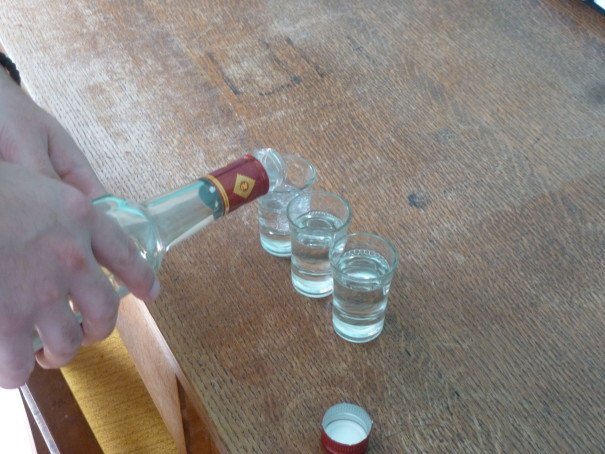
Rakija’s Saving Grace

Rakija’s Saving Grace
Slivovica in Croatia
Our first morning in Zagreb, my buddy Dylan and I readily accepted shots of rakija when offered. Something needed to improve a day that had started with an overnight lockout from our lodging, a Catholic seminary, and a torrential downpour. Only at 7 am did a boyish and bespectacled seminary student peer his head out a second-floor window, introduce himself as Alex, and let us in.
He insisted that he’d show us Zagreb’s religious sites after a shower and a nap. But not before a pre-excursion drink in his room: a small rectangle with a bed, religious icons, and his private (re: not seminary acceptable) footlocker that held half a dozen exquisitely shaped and colored bottles and flasks. The occasion apparently called for an unassuming bottle of clear liquid—already half finished—that he fished from the bottom. It was a plum rakija—slivovica—distilled at home, just over the border with Bosnia. He poured out three sloppy shots, and then we all pulled.
I came close to spitting it out. The smell and taste were more gasoline than fruit, the stomach fire less warming than temporarily nauseating. He chuckled before pouring another round.
At 12:30, well on my way to day-drunk, we left the room.
We started downstairs with the seminary itself. Incense holders resurrected as candle fixtures illuminated a maze of otherwise austere, bleached hallways. Thick wooden doors linked between the warm pastels of the kitchens, student common rooms, and the sanctuary, a collection of icons and tapestries bathed in golden light or paint.
He kept us moving, now toward the twin spires of the Zagreb Cathedral. The rakija began to hit, and I started swaying and sweating uncontrollably. Alex wasn’t perturbed in his natural environment. Walking underneath a cavernous rooftop and chandelier, he energetically whispered about Croatian Catholic practice (Catholic with Orthodox influence) and priestly life (girlfriends, like his, were fine so long as found before commencing seminary studies).
The rakija wore off on the walk to our last destination, the Serbian Orthodox Cathedral. He kept quiet there. Either he didn’t know as much about this location or just didn’t feel like addressing the traditional ethnic dimensions to Balkan religion, an understandably loaded topic. We just stood in the central floor swiveling our heads to gaze on eerie icons and frescoes of biblical scenes. Before Alex left us for good to visit his girlfriend, he handed us the rest of the family bottle from his pocket.
The next night, my 21st birthday, we fell back into the trap of hostel pub crawls until reaching Dubrovnik a few nights later. On the last of three nights in the city, we bought a liter of convenience-store travarica, an herbal rakija. Drink in hand, we walked briskly across the Old Town to find somewhere calm and secluded to get plastered as evening turned into pitch-black night. Patient searching revealed an unlocked gate in the city wall through which we spotted a drinking spot ideal for shitty rakija: a rocky plateau jutting out of the water 100 feet below us, down a mossy staircase carved into the rock.
First shot mine. Rough at first, like alcoholic lemon Pledge. Dylan’s shot. No response.
My shot. His. Mine. His. And so on for eight more rounds punctuated occasionally by nausea and slurred—but energetic—conversation.
We sent a prayer Alex’s way before groping our way back up the rock path toward tomorrow morning’s hangover. Someone certainly answered us. Our stagger out of the Old City into a cab, through dimly-lit alleys and wide pedestrian boulevards, past marble columns and architectural jewels, ended without incident. Even better, we still had half the bottle left.